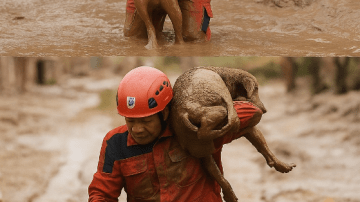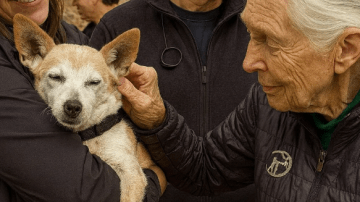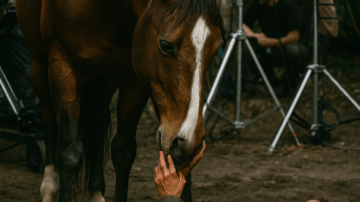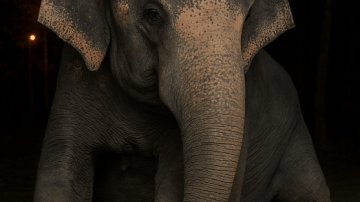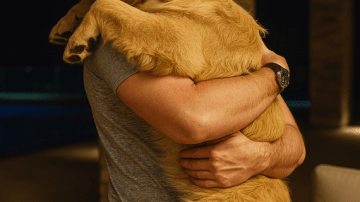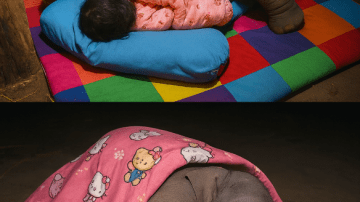On the edge of a small, forgotten village, where dust hung heavy in the air and cracked roads told stories of neglect, there lived a mother dog named Hope. Her name was never spoken by humans—no one in the village cared enough to call her anything. Yet, the villagers who occasionally tossed her scraps would later agree: no other name could have captured her spirit more perfectly.

Hope was heavily pregnant, her belly round and taut, carrying the promise of life within her frail body. But the promise of life came with the cruel weight of loneliness. Her owner, a man hardened by indifference, rarely glanced her way. A dish of water would sometimes be left out, stale and warm, but food was never guaranteed. Day after day, Hope wandered the village streets, her ribs faintly visible beneath her thinning fur, scavenging in garbage bins and sniffing the dirt for crumbs. Her body ached, her paws grew sore, and yet her instinct to protect the unborn lives inside her kept her moving. In every scrap she found, she imagined a future where her pups might taste comfort she herself had never known.

But fate can be merciless. One afternoon, as the village buzzed with the faint hum of motorcycles and chatter from the market, Hope tried to cross a busy intersection. Perhaps she had caught the faint aroma of discarded bread on the other side. Perhaps she simply wanted to reach a quiet corner where she could rest. She never saw the car. It came roaring down the cracked road, its driver distracted, the tires screeching too late. The impact struck Hope’s small frame with a force that silenced the street for a moment. Her fragile body was flung to the ground, the air punched from her lungs. The damage was horrific. Her femur was shattered, twisted at an unnatural angle. Her hindquarters scraped mercilessly against the pavement, tearing her skin until blood streaked the gray concrete. She whimpered—soft, broken sounds that few even noticed. The car sped away without slowing. To the driver, she was nothing more than a shadow in the road.
Hope lay there, trembling, each breath ragged and shallow. Pain surged like fire through her veins, but deep inside her, something stronger than pain stirred: the will to live, not for herself, but for the lives she still carried inside. The days that followed were a blur of suffering. With her body broken, moving was torture, yet she dragged herself into alleyways and quiet corners to hide. Her wounds oozed, attracting flies. Hunger gnawed at her. Thirst burned in her throat. Each step was agony, yet she forced herself onward, driven by a primal instinct to find a safe place for her puppies.

Five days passed like this—five days of torment no creature should endure. But on the fifth day, beneath the shade of a half-collapsed shed, her body finally gave in to its natural rhythm. Labor began. Hope’s cries echoed softly into the night as, one by one, ten fragile, whimpering puppies entered the world. They were tiny, blind, and utterly helpless, pressing instinctively against their mother’s wounded body for warmth and milk. Though her body trembled from exhaustion, though pain radiated through every bone and muscle, Hope licked each pup clean, nudging them close, whispering a silent vow to protect them as long as she could.
The days after the birth were even harder. Hope’s injuries made it nearly impossible to stand, let alone search for food. Her milk was thin, barely enough to sustain so many mouths. Still, she let her pups feed, even as her own strength faded. Kind-hearted villagers began to notice her plight. A woman passing by left scraps of boiled rice. A boy dropped half a piece of bread near her resting spot. These gestures kept her alive, though they were not enough to heal her wounds or fill the empty ache in her body. But news spreads quickly in small places. Whispers of a wounded mother dog who had birthed ten puppies despite her shattered body began to travel through the village. People spoke of her resilience with awe and sorrow. Some shook their heads at the cruelty of her owner, who had all but abandoned her. Others prayed quietly for her survival.
Among those who heard her story was a small but dedicated rescue force. These were not wealthy people. They did not have large shelters or endless resources. But what they did have were hearts big enough to carry the pain of abandoned animals, and hands strong enough to lift them out of despair. The rescue team set out to find her, guided by the villagers’ descriptions. It did not take long. In the corner of the shed, lying on a cold, dirt floor, they saw her: Hope, her body a patchwork of wounds and scars, her eyes dim yet alert, surrounded by ten tiny pups pressed close against her side. For a moment, the rescuers stood frozen, the scene before them both heartbreaking and awe-inspiring. How had this dog survived? How had she endured five days of suffering, only to bring life into the world?
They approached slowly, speaking in gentle tones, fearing she might lash out in fear. But Hope did not growl, did not bare her teeth. She only looked up at them with eyes that seemed to plead, “Help me. Help them.” With careful hands, they lifted her broken body onto a blanket. One rescuer cradled the tiny pups, placing them gently into a box lined with cloth. Hope never took her eyes off them, whining softly until they were placed beside her again. And just like that, the nightmare ended.
Hope and her puppies were taken far away from the place of neglect and cruelty. The rescue team promised she would never again feel the cold sting of hunger, the burning ache of untreated wounds, or the despair of abandonment. Veterinarians examined her, cleaning her sores and bandaging her shattered leg. It would take time, they said, perhaps even surgery, but with care, she could heal. More importantly, her puppies—tiny, fragile, but alive—would grow up safe, with a chance at the love their mother had been denied for so long. Hope lay on a soft bed for the first time in her life, her pups nestled against her. For the first time, she closed her eyes without fear.

In the weeks that followed, the villagers often asked about her. Stories of her courage spread beyond the village, shared on phones and whispered in marketplaces. People marveled not just at her survival, but at her willpower—the fierce determination of a mother who refused to surrender, even when the world seemed to conspire against her. Hope became more than just a dog. She became a symbol of resilience, a reminder that love and courage can survive even in the harshest conditions. And though she could not speak in words, her story spoke louder than any language: that even in suffering, life is worth fighting for, and that even in despair, there is hope.

